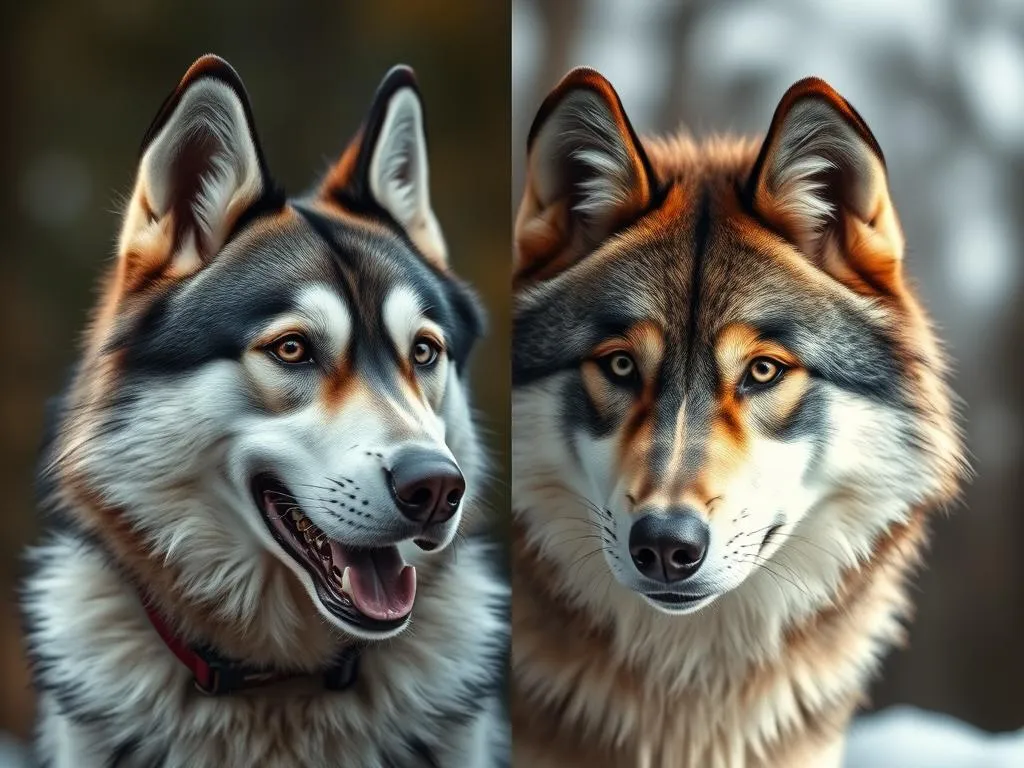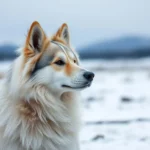
Introduction
In the world of canines, the diversity of dog breeds offers a fascinating glimpse into the traits and characteristics that make each breed unique. Among the most captivating comparisons is that of the Husky vs Wolf. Understanding these breeds not only enhances our appreciation for them but also helps potential pet owners make informed choices. This article delves into the similarities and differences between Huskies and wolves, providing a thorough examination of their traits, behaviors, and histories.
Understanding Dog Breeds
What is a Dog Breed?
A dog breed is a specific group of domestic dogs with distinct characteristics, physical traits, and temperament. Breeds are classified based on their lineage, purpose, and appearance. There are over 340 recognized dog breeds worldwide, each adhering to breed standards set by organizations like the American Kennel Club (AKC). These standards ensure that breeds maintain consistent qualities across generations, making it easier for potential owners to understand what to expect from a particular breed.
History of Domestication
The domestication of dogs is believed to have begun over 15,000 years ago, stemming from the gray wolf. As humans transitioned from nomadic hunter-gatherers to settled agricultural societies, they began to form mutually beneficial relationships with wolves. Through selective breeding, certain traits were enhanced, leading to the development of various dog breeds, including the Husky. This evolution has resulted in a wide range of breeds, each adapted to different roles, environments, and human needs.
Overview of the Siberian Husky
Origins and History
The Siberian Husky originated from the Chukchi people of Siberia, who bred these dogs for sledding and companionship. Their ability to withstand harsh climates and work in teams made them invaluable to the Chukchi, who relied on them for transportation and hunting. The breed was introduced to North America in the early 20th century and quickly gained popularity due to its striking appearance and friendly demeanor.
Physical Characteristics
Siberian Huskies are medium-sized dogs, typically weighing between 35 to 60 pounds and standing about 20 to 24 inches tall at the shoulder. They are known for their thick double coat, which can come in various colors, including black, gray, red, and agouti. One of the most distinctive features of Huskies is their striking eyes, which can be blue, brown, or even one of each. Their erect ears and bushy tails give them a unique and recognizable look.
Temperament and Behavior
Huskies are known for their friendly and outgoing nature. They are highly social animals that thrive on interaction with humans and other dogs. Their energy levels are high, and they require significant exercise to stay happy and healthy. Huskies are often described as independent and can be quite stubborn, making consistent training essential. They are not typically aggressive, but their strong prey drive can lead to chasing small animals.
Common Health Issues
While Huskies are generally healthy dogs, they can be prone to certain health issues, including hip dysplasia, eye disorders (like cataracts), and skin conditions. Their lifespan averages between 12 to 15 years, and proper care, including regular veterinary check-ups and a balanced diet, is crucial for maintaining their health.
Overview of the Wolf
Species and Classification
The gray wolf (Canis lupus) is the most recognized species of wolf and has several subspecies. Unlike domesticated dogs, wolves have retained their wild instincts and behaviors. While they share a common ancestor with dogs, the differences in their evolution and domestication have led to distinct characteristics that set them apart.
Physical Characteristics
Wolves are larger than Huskies, typically weighing between 50 to 110 pounds and standing 26 to 34 inches tall at the shoulder. They have long legs, a broad head, and a thick, bushy tail. Their fur color can vary significantly, ranging from white and gray to brown and black. Wolves have a powerful build, designed for endurance and strength, which is essential for their survival in the wild.
Natural Behavior
Wolves are social animals that live in packs, which are typically composed of a family unit. Their pack dynamics are complex, involving established hierarchies and cooperative behaviors. Wolves are skilled hunters, relying on teamwork and strategy to take down prey. Their natural instincts drive them to cover large territories in search of food, and they communicate using a range of vocalizations, body language, and scent marking.
Habitat and Range
Wolves inhabit a variety of ecosystems, including forests, tundras, and grasslands. Their geographic distribution spans across North America, Europe, and Asia. Adaptations to different environments allow them to thrive in diverse habitats, from the Arctic tundra to temperate forests. Conservation efforts are crucial for maintaining wolf populations, as habitat loss and hunting pose significant threats.
Husky vs Wolf – Key Comparisons
Genetic Similarities
When comparing Huskies and wolves, one of the most striking similarities is their genetic makeup. Both belong to the same species group, with dogs and wolves sharing approximately 98% of their DNA. However, domestication has led to notable variations in behavior and physical traits. While Huskies have been bred for companionship and work, wolves have retained their wild instincts, making their behaviors and needs quite different.
Physical Similarities and Differences
On a superficial level, Huskies and wolves share several physical traits, such as their wolf-like appearance and thick fur. However, there are key differences. Huskies are generally smaller and have a more refined build compared to the robust and muscular structure of wolves. Furthermore, Huskies often exhibit a wider range of coat colors and patterns, while wolves usually have more uniform fur coloration that blends into their natural surroundings.
Behavioral Comparisons
Behaviorally, Huskies and wolves exhibit significant differences. Huskies are socialized to interact with humans and other dogs, often displaying affectionate and playful behaviors. In contrast, wolves rely on their pack for survival and exhibit more instinctual behaviors related to hunting and territory. While both can be trained to some extent, Huskies are generally more receptive to human guidance, while wolves retain a strong instinct to follow their natural behaviors and pack dynamics.
Domestication Impact
The impact of domestication on Huskies is profound. Through selective breeding, their behaviors have been altered to suit human companionship. Huskies are generally more adaptable to living with humans and often seek human interaction. Wolves, on the other hand, have remained largely unchanged, with wild instincts driving their behaviors. Understanding these differences is essential for potential dog owners, as it highlights the unique challenges and rewards of owning a Husky compared to interacting with a wild wolf.
Living with Huskies
Training and Socialization
Training a Husky requires patience and consistency. Due to their independent nature, they can be stubborn learners. Positive reinforcement techniques, such as treats and praise, work best for training Huskies. Early socialization is critical; exposing them to various people, environments, and other animals helps them develop into well-rounded companions.
Exercise and Mental Stimulation
Huskies are high-energy dogs that require plenty of exercise. Daily activities should include long walks, runs, or play sessions. Engaging in activities like agility training or dog sports can provide the physical and mental stimulation they need. Interactive toys that challenge their intelligence are also beneficial, as Huskies enjoy problem-solving and play.
Grooming and Care Needs
Huskies have a thick double coat that requires regular grooming, especially during shedding seasons. Brushing them at least once a week helps manage loose hair and keeps their coat healthy. Nutritional needs vary by age, activity level, and health, so it’s essential to provide a balanced diet tailored to their specific requirements. Regular veterinary check-ups are crucial for monitoring their health and addressing any potential issues early.
The Wolf in the Wild
Conservation Status
Wolves face numerous threats in the wild, including habitat destruction, hunting, and conflicts with livestock. Conservation status varies by region, with some populations being endangered or threatened. Organizations dedicated to wolf conservation work tirelessly to protect these magnificent animals and their habitats, promoting coexistence between humans and wolves.
Interaction with Humans
The relationship between wolves and humans is complex. Many myths portray wolves as dangerous predators; however, in reality, they tend to avoid human contact. Understanding wolf behaviors and their role in the ecosystem is essential for fostering coexistence. Education and awareness can help dispel myths and promote conservation efforts, ensuring a more harmonious relationship between humans and wolves.
Conclusion
In summary, the comparison of Huskies and wolves reveals both fascinating similarities and stark differences. While they share a common ancestry and certain physical traits, their behaviors, living conditions, and interactions with humans diverge significantly due to the effects of domestication and evolution. Understanding these distinctions is crucial for responsible pet ownership and appreciating the unique qualities of both breeds. As we delve deeper into the world of canines, we enhance our connection with these remarkable animals, whether they are beloved pets or wild creatures of the forest.









